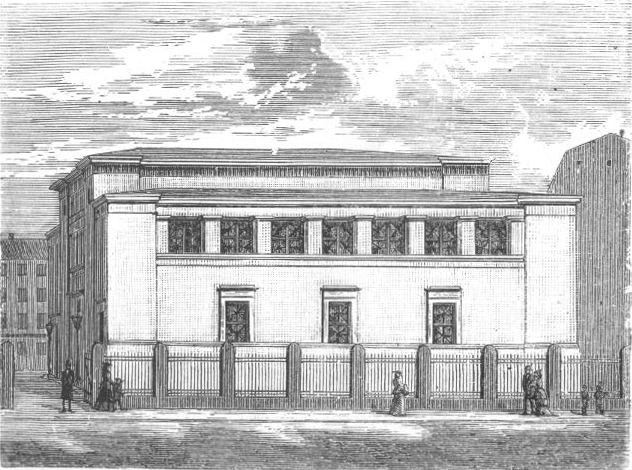|
Rescue Of The Danish Jews
The Danish resistance movement, with the assistance of many Danish citizens, managed to evacuate 7,220 of Denmark's 7,800 Jews, plus 686 non-Jewish spouses, by sea to nearby neutral Sweden during the Second World War. Leo Goldberger: ''The Rescue of the Danish Jews: Moral Courage Under Stress'' , 1987, preface pages XXLinked 2014-04-29 The arrest and deportation of was ordered by the German leader |
Jewish Question
The Jewish question, also referred to as the Jewish problem, was a wide-ranging debate in 19th- and 20th-century European society that pertained to the appropriate status and treatment of Jews. The debate, which was similar to other " national questions", dealt with the civil, legal, national, and political status of Jews as a minority within society, particularly in Europe during the 18th, 19th, and 20th centuries. The debate began with Jewish emancipation in western and central European societies during the Age of Enlightenment and after the French Revolution. The debate's issues included the legal and economic Jewish disabilities (such as Jewish quotas and segregation), Jewish assimilation, and Jewish Enlightenment. The expression has been used by antisemitic movements from the 1880s onwards, culminating in the Nazi phrase of the " Final Solution to the Jewish Question". Similarly, the expression was used by proponents for and opponents of the establishment of an aut ... [...More Info...] [...Related Items...] OR: [Wikipedia] [Google] [Baidu] |
Chief Rabbi
Chief Rabbi ( he, רב ראשי ''Rav Rashi'') is a title given in several countries to the recognized religious leader of that country's Jewish community, or to a rabbinic leader appointed by the local secular authorities. Since 1911, through a capitulation by Ben-Zion Meir Hai Uziel, Israel has had two chief rabbis, one Ashkenazi and one Sephardi. Cities with large Jewish communities may also have their own chief rabbis; this is especially the case in Israel but has also been past practice in major Jewish centers in Europe prior to the Holocaust. North American cities rarely have chief rabbis. One exception however is Montreal, with two—one for the Ashkenazi community, the other for the Sephardi. Jewish law provides no scriptural or Talmudic support for the post of a "chief rabbi." The office, however, is said by many to find its precedent in the religio-political authority figures of Jewish antiquity (e.g., kings, high priests, patriarches, exilarchs and ''gaonim''). ... [...More Info...] [...Related Items...] OR: [Wikipedia] [Google] [Baidu] |
Curfew
A curfew is a government order specifying a time during which certain regulations apply. Typically, curfews order all people affected by them to ''not'' be in public places or on roads within a certain time frame, typically in the evening and nighttime hours. Such an order may be issued by public authorities but also by the owner of a house to those living in the household. For instance, an au pair was typically given a curfew, which regulates when they must return to the host family's home in the evening. Curfews were a common element of control used in martial law, though curfews can also be implemented for public safety in the event of a disaster, pandemic, or crisis. Etymology The word "curfew" comes from the Old French phrase "''couvre-feu''", which means "cover fire". It was later adopted into Middle English as "curfeu", which later became the modern "curfew". Its original meaning refers to a law made by William the Conqueror that all lights and fires should be covere ... [...More Info...] [...Related Items...] OR: [Wikipedia] [Google] [Baidu] |
Sabotage
Sabotage is a deliberate action aimed at weakening a polity, effort, or organization through subversion, obstruction, disruption, or destruction. One who engages in sabotage is a ''saboteur''. Saboteurs typically try to conceal their identities because of the consequences of their actions and to avoid invoking legal and organizational requirements for addressing sabotage. Etymology The English word derives from the French word , meaning to "bungle, botch, wreck or sabotage"; it was originally used to refer to labour disputes, in which workers wearing wooden shoes called interrupted production through different means. A popular but incorrect account of the origin of the term's present meaning is the story that poor workers in the Belgian city of Liège would throw a wooden into the machines to disrupt production. One of the first appearances of and in French literature is in the of d'Hautel, edited in 1808. In it the literal definition is to 'make noise with sabots' a ... [...More Info...] [...Related Items...] OR: [Wikipedia] [Google] [Baidu] |
North Africa
North Africa, or Northern Africa is a region encompassing the northern portion of the African continent. There is no singularly accepted scope for the region, and it is sometimes defined as stretching from the Atlantic shores of Mauritania in the west, to Egypt's Suez Canal. Varying sources limit it to the countries of Algeria, Libya, Morocco, and Tunisia, a region that was known by the French during colonial times as "''Afrique du Nord''" and is known by Arabs as the Maghreb ("West", ''The western part of Arab World''). The United Nations definition includes Morocco, Algeria, Tunisia, Libya, Egypt, Sudan, and the Western Sahara, the territory disputed between Morocco and the Sahrawi Republic. The African Union definition includes the Western Sahara and Mauritania but not Sudan. When used in the term Middle East and North Africa (MENA), it often refers only to the countries of the Maghreb. North Africa includes the Spanish cities of Ceuta and Melilla, and plazas de so ... [...More Info...] [...Related Items...] OR: [Wikipedia] [Google] [Baidu] |
Battle Of Stalingrad
The Battle of Stalingrad (23 August 19422 February 1943) was a major battle on the Eastern Front of World War II where Nazi Germany and its allies unsuccessfully fought the Soviet Union for control of the city of Stalingrad (later renamed to Volgograd) in Southern Russia. The battle was marked by fierce close-quarters combat and direct assaults on civilians in air raids, with the battle epitomizing urban warfare. The Battle of Stalingrad was the deadliest battle to take place during the Second World War and is one of the bloodiest battles in the history of warfare, with an estimated 2 million total casualties. Today, the Battle of Stalingrad is universally regarded as the turning point in the European Theatre of war, as it forced the '' Oberkommando der Wehrmacht'' (German High Command) to withdraw considerable military forces from other areas in occupied Europe to replace German losses on the Eastern Front, ending with the rout of the six field armies of Army ... [...More Info...] [...Related Items...] OR: [Wikipedia] [Google] [Baidu] |
Copenhagen
Copenhagen ( or .; da, København ) is the capital and most populous city of Denmark, with a proper population of around 815.000 in the last quarter of 2022; and some 1.370,000 in the urban area; and the wider Copenhagen metropolitan area has 2,057,142 people. Copenhagen is on the islands of Zealand and Amager, separated from Malmö, Sweden, by the Øresund strait. The Øresund Bridge connects the two cities by rail and road. Originally a Viking fishing village established in the 10th century in the vicinity of what is now Gammel Strand, Copenhagen became the capital of Denmark in the early 15th century. Beginning in the 17th century, it consolidated its position as a regional centre of power with its institutions, defences, and armed forces. During the Renaissance the city served as the de facto capital of the Kalmar Union, being the seat of monarchy, governing the majority of the present day Nordic region in a personal union with Sweden and Norway ruled by the ... [...More Info...] [...Related Items...] OR: [Wikipedia] [Google] [Baidu] |
Great Synagogue (Copenhagen)
The Great Synagogue is the main synagogue of the Jewish community in Copenhagen, Denmark. The synagogue is defined by its unique architecture around the Ark. During the first half of the 19th century, synagogues continued to be built in the classical tradition, but there began to be a revival of Greek and Roman architecture. The Great Synagogue in Copenhagen is one of a few synagogues of its period to use Egyptian elements in the columns, ceiling and cornice over the ark. History Arrival of Jews into Denmark Jews were first welcomed into Denmark in 1622 when they were invited into the country by Denmark's king. Although they were scattered around, many of the Jews settled in Copenhagen. Abraham Salomon became the first rabbi in the country in 1687. From 1766 until 1795, around 1,500 Jews worshipped in a small synagogue until it burned down. After the synagogue burned down, a division occurred between the orthodox and progressive members of the Jewish community. As a result, th ... [...More Info...] [...Related Items...] OR: [Wikipedia] [Google] [Baidu] |
Arson
Arson is the crime of willfully and deliberately setting fire to or charring property. Although the act of arson typically involves buildings, the term can also refer to the intentional burning of other things, such as motor vehicles, watercraft, or forests. The crime is typically classified as a felony, with instances involving a greater degree of risk to human life or property carrying a stricter penalty. Arson which results in death can be further prosecuted as manslaughter or murder. A common motive for arson is to commit insurance fraud. In such cases, a person destroys their own property by burning it and then lies about the cause in order to collect against their insurance policy. A person who commits arson is referred to as an arsonist, or a serial arsonist if arson has been committed several times. Arsonists normally use an accelerant (such as gasoline or kerosene) to ignite, propel and directionalize fires, and the detection and identification of ignitable l ... [...More Info...] [...Related Items...] OR: [Wikipedia] [Google] [Baidu] |
Hermann Göring
Hermann Wilhelm Göring (or Goering; ; 12 January 1893 – 15 October 1946) was a German politician, military leader and convicted war criminal. He was one of the most powerful figures in the Nazi Party, which ruled Germany from 1933 to 1945. A veteran World War I fighter pilot ace, Göring was a recipient of the ("The Blue Max"). He was the last commander of ''Jagdgeschwader'' 1 (Jasta 1), the fighter wing once led by Manfred von Richthofen. An early member of the Nazi Party, Göring was among those wounded in Adolf Hitler's failed Beer Hall Putsch in 1923. While receiving treatment for his injuries, he developed an addiction to morphine which persisted until the last year of his life. After Hitler became Chancellor of Germany in 1933, Göring was named as minister without portfolio in the new government. One of his first acts as a cabinet minister was to oversee the creation of the Gestapo, which he ceded to Heinrich Himmler in 1934. Following the establishment of th ... [...More Info...] [...Related Items...] OR: [Wikipedia] [Google] [Baidu] |
Erik Scavenius
Erik Julius Christian Scavenius (; 13 July 1877 – 29 November 1962) was the Danish foreign minister from 1909 to 1910, 1913 to 1920 and 1940 to 1943, and prime minister from 1942 to 1943, during the occupation of Denmark until the Danish elected government ceased to function. He was the foreign minister during some of the most important periods of Denmark's modern history, including the First World War, the plebiscites over the return of northern Schleswig to Denmark, and the German occupation. Scavenius was a member of the Landsting (the upper house of the Danish parliament before 1953) from 1918 to 1920 and from 1925 to 1927 representing the Social Liberal Party. He was chairman of its party organization from 1922 to 1924. Scavenius belonged to a tradition of elite governance that distrusted democratically elected politicians at a time when they were gaining power and influence. He believed that many of them were influenced by ignorant strains of populism and ill-equipped ... [...More Info...] [...Related Items...] OR: [Wikipedia] [Google] [Baidu] |






